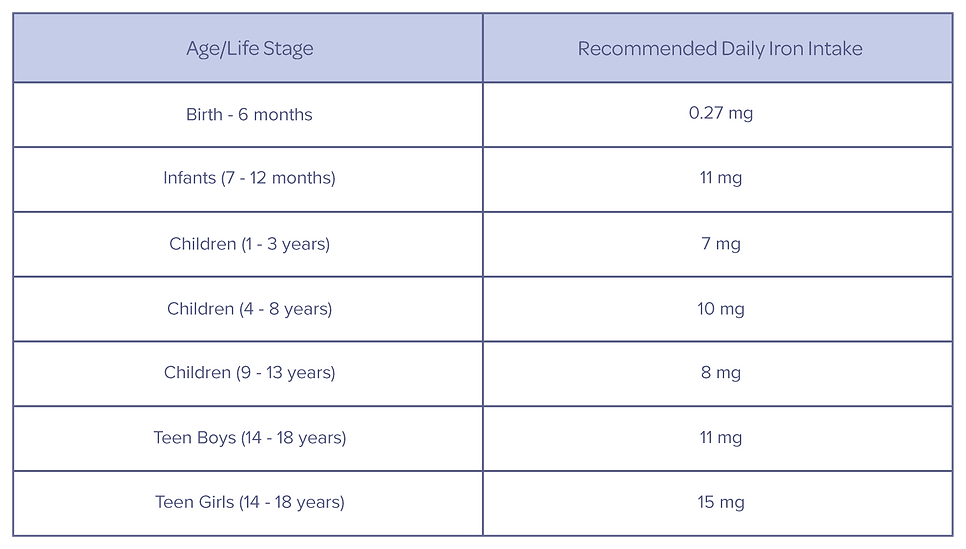
Treatment
Quick Reference:
Treatment Suggestions

Oral iron


Re-Assess Ferritin
or Iron Studies
Intravenous Iron
Oral Iron
Oral iron is often the first line of therapy for iron deficiency [9,15,29].
Iron salts (ferrous gluconate, sulfate or fumarate) should be used as first line oral iron therapy, as they are less expensive and there is no robust evidence that their more expensive counterparts (polysaccharide, heme-based or liposomal irons) are more effective [9].
The best iron supplement is the one that a patient tolerates and takes consistently.
Patients should be counseled on the ideal administration of oral iron (visit Take Control Period for a patient-facing resource on how to take oral iron properly):
-
Take one pill, once a day
-
Take on an empty stomach
-
Avoid these foods and medications within 2 hours before and after taking iron
-
If needing to be taken with food, take it with citrus fruit such as orange, lemon, grapefruit, tangerine, apple, tomato
-
Manage potential adverse effects, including dark stools, upset stomach, bloating, diarrhea, nausea, and constipation, by:
-
Increasing consumption of fiber and fluids, and take daily polyethylene glycol (PEG)
-
Taking the iron pill every other day – there is preliminary evidence that every other day therapy may be more effective, and better tolerated, than daily therapy, however this observation needs to be counterbalanced by the potential for intermittent dosing to reduce compliance.
-
Trying a different formulation
-
Formulations of Iron

Re-Assess Ferritin or Iron Studies
It is essential to re-assess ferritin (or iron studies, in the case of concomitant inflammation) 3 months following initiation of therapy, which should demonstrate notable improvement in the absence of ongoing losses or high demands (e.g. pregnancy) [23,29,33].
Intravenous (IV) Iron
IV iron should be considered in cases where there is excessive blood loss, malabsorption, impending deadlines (e.g., surgical intervention, upcoming childbirth), iron restricted states (i.e., in cases of chronic inflammation), and severe symptoms affecting quality of life [9,29,32,33,44]. Ferritin and/or iron studies should be re-assessed no sooner than 4 weeks following receipt of intravenous iron.
IV iron can be used in any patient who does not tolerate oral iron, when a trial of oral iron has been ineffective, in a patient with severe anemia to avoid the need for transfusion, or in the context of malabsorption (e.g., bariatric surgery or active inflammatory bowel disease), including in pregnant women in the 2nd and 3rd trimester of pregnancy [53]. Total dose requirements can be approximated using iron deficit calculations but must consider ongoing losses of iron [54] – in most cases replacement therapy is best monitored with serial ferritin determinations. Blood transfusions should be reserved for emergency indications only (e.g. hypotension, massive hemorrhage).
Types of IV Iron [42,55-70]

How to Dose IV Iron
Total dose requirements can be approximated using iron deficit calculations but must consider ongoing losses of iron – in most cases replacement therapy is best monitored with serial ferritin determinations [54]. Ferritin and/or iron studies should be re-assessed no sooner than 4 weeks following receipt of intravenous iron. In the absence of ongoing iron losses (i.e. bleeding), patients generally need 1-1.5 grams of iron.
Blood transfusions should be reserved for emergency indications only (e.g. hypotension, massive hemorrhage).
IV Iron Adverse Effects
IV iron carries a minimal (1:100-250) risk of inducing a minor infusion reaction that can include flushing, urticaria, pruritus, or chest and/or back pressure. Severe adverse events are exceedingly rare. Some have estimated the rate of anaphylaxis with IV iron to be less than 1 per 250 000 administrations. Self-limiting hypophosphatemia has been noted in some patients receiving IV iron and may manifest with symptoms similar to iron deficiency.
There is no evidence that one formulation of currently available IV iron is safer than another. Thus, administration of any currently available formulation (IV iron sucrose or IV ferric derisomaltose) can be considered, however formulations administered as a single total dose infusion are recommended over formulations requiring multiple dose infusions in non-pregnant and pregnant people [71].





